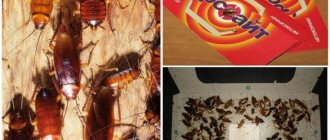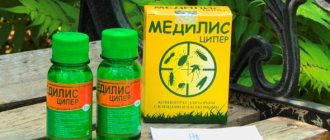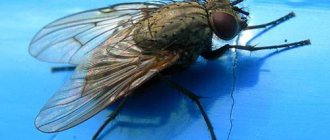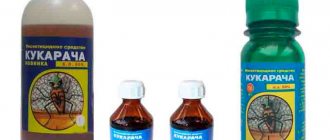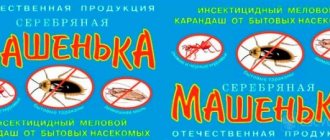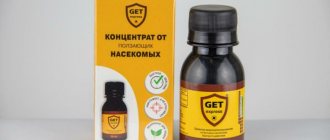Content
- Purpose and application
- Composition and dosage form
- Mechanism of action
- Regulations for the use of the drug "Cypermethrin 25, EC"
- Compatibility
- Analogues and preparations containing cypermethrin
- Security and restrictions
- Advantages and disadvantages of application
- Advantages of using the drug "Cypermethrin 25, EC"
- Disadvantages of using the drug "Cypermethrin 25, EC"
"Cypermethrin" is an effective drug with a wide spectrum of action. The material contains the purpose, composition, mechanism of action, regulations for use, restrictions, analogues, etc.
beta-cypermethrin: human health
Basic indicators:
| Index | Meaning | Source / Qualitative indicators / Other information | Explanation | |
| Mammals - Acute oral LD50 (mg/kg) | 166 | L3 Rat | Moderately | |
| Mammals - Skin LD50 (mg/kg body weight) | > 5000 | L3 Rat | — | |
| Mammals - Inhalation CK50 (mg/l) | 1.97 | L3 Rat | — | |
| ADI - permissible daily dose (mg/kg body weight per day) | 0.02 | L3 | — | |
| ARfD - average daily intake (mg/kg body weight per day) | — | — | — | |
| AOEL - acceptable systemic operator exposure level | — | — | — | |
| Skin absorption (%) | — | — | — | |
| Hazardous Substances Directive 76/464/EC | — | — | — | |
| Types of restrictions | — | — | — | |
| by category | Are common: | — | ||
| Professional: | — | |||
| Examples of European MRLs (mg/kg) | Meaning: | — | ||
| Note: | ||||
| MPC in drinking water (µg/l) | — | — | — | |
Toxicological and hygienic characteristics:
| ? | ? | — | X | X | X | X | X | — |
| Effect on humans | [No further information available] | |||||||
V: Yes, it is known what causes it X: No, it is known what does not cause it? : Possibly, not exactly determined - : No data
Legislation:
| Index | Meaning | Source / Qualitative indicators / Other information | Explanation | ||||
| Basics | [No information available] | ||||||
| European Commission Risk Classification | [T+ - Very high toxicity: R26/28], | ||||||
| European Commission safety classification | — | ||||||
| WHO classification | NL | — | Not described | ||||
| US Environmental Protection Agency (US EPA) classification | — | — | — | ||||
| UN Number | — | ||||||
| Packaging and disposal | — | ||||||
Purpose and application
The drug "Cypermethrin" is used both independently and in mixtures with other active ingredients.
Areas of use:
a) rural and personal household plots to combat insect pests :
- grapes (leaf rollers);
- potatoes (Colorado beetle, potato ladybird);
- cucumbers and tomatoes in protected soil (whiteflies, aphids, thrips);
- cabbage and leafy greens (leaf-eating caterpillars);
- apple trees, pears (codling moth, leaf rollers);
- currants (aphids, moths, leaf rollers, sawflies)
b) protection from pests of agricultural crops and stocks (cereal aphids, thrips, pest bugs, ants, ground beetles, stem flies, flax flea beetles, meadow moths, etc.);
c) medical and veterinary practice (ixodid ticks, etc.);
d) sanitary and household disinsection of premises for the destruction of flightless synanthropic insects (fleas, cockroaches, bed bugs) and for treating fly landing sites.
The effect of the drug applies to both larvae and adult insects.
Composition of cypermethrin
Cypermethrin as an insecticidal and acaricidal agent is a mixture of several substances that have the same chemical formula, but different spatial molecular structures and properties. Let us remind you who has forgotten - chemists call such substances isomers.
The basic cypermethrin molecule and examples of its isomers
The basic cypermethrin molecule is shown on the left in the figure; It is an ester of cyclopropanecarboxylic acid. Its, figuratively speaking, “sting” is the cyano group (highlighted in yellow). In the center and on the right are examples of isomers; in principle there can be many more of them. The pale arrows show how the internal interactions in the molecule change during isomerization, which causes the difference in the physical and chemical properties of the isomers.
The mechanism of pest protection from cypermethrin at the molecular level
Isomerization of complex molecules is possible because chemical bonds are a kind of hinges on which parts of the molecule can rotate relative to each other. This circumstance is used by target organisms to protect themselves from poisons; of course, unconsciously. “Counterparties” enzymes most strongly attack weak “hinges”, then those that are stronger, and last of all they try to tear off weakly bound chemical groups - “pendants”, see fig. on right. There is a complete analogy with war: if the front breaks through, victory is assured, but distracting and disturbing operations also do their job. As a result, the base molecule is destroyed and loses its effectiveness, because without “framing” its active principle is little or completely non-toxic.
The composition of the drug cypermethrin includes 8 isomers of the base molecule in cis- and trans-forms, in groups that are effective against coleoptera, lepidoptera and arachnids. Cis- and trans-isomers are the next stage of isomerization: molecules with the same sequence of components, but as if in a mirror image. Thanks to the complex isomeric composition, more and more new “units” “enter the battle”, and the “enemy” is forced to disperse its forces and is not able to “hold the line” for a long time; This explains the lack of resistance of affected objects to cypermethrin.
Note: for the opinion of pest control specialists on the effectiveness of cypermethrin compared to other drugs, see the video:
Video: effectiveness of cypermethrin
Composition and dosage form
"Cypermethrin 25, EC" is a single drug. The main active ingredient is Cypermethrin , concentration 250ml/1l. (25%) – a chemical substance of the pyrethroid class.
The release format is EC (emulsion concentrate) with a dosage of 25% of the active substance. This is the maximum concentration in the line of drugs.
Insecticide "Cypermethrin 25, EC" for professional disinfestation, packaging 1 liter. and 5 l.
Doses and processing rates
Cypermethrin is used in working solutions with concentrations up to and including 0.1% more concentrated. If in a certain case a “strong” solution is required, then it is better to entrust disinfestation to professionals - it is too expensive, troublesome and dangerous to do it yourself. Depending on the degree of damage by the same pest, the concentration of the solution from it may be lower or higher than specified. In general, the instructions for using cypermethrin are as follows:
- For bed bugs with minor infestation (up to 5 bite marks on the body per night) - 0.01% solution. Consumption rate 50 ml per 1 sq. m of non-absorbent surface and 100 per 1 sq. m absorbent. The nearest places of possible nests are processed: the bed, its headboard, bedside rugs and nightstands, the backs of pictures/posters above the bed. The period of protective action without steaming from eggs (see above) is 1.5 months.
- The same, for more severe infection - 0.05% solution; consumption rates are the same. They process possible places of settlement and paths of settlement throughout the entire room: all cracks, peeling wallpaper, furniture, dry plaster. Protection period without steaming is 3 months.
- For cockroaches – 0.1% solution; The application rates are the same as for bedbugs. Treatment areas - as in case of severe bedbug infestation simultaneously in all infected premises; in addition, all waste collection accessories and garbage chutes. If cockroaches are noticed during the day (the population is excessive, overcrowding), adjacent rooms are also treated. Repeated treatment is carried out no earlier than after 60 days.
- From flies inside - 0.01% solution for irregular visits and 0.05% if objects are constantly hovering and quickly lingering. Consumption 100 ml per 1 sq. m. 75% of the solution volume is pollinated by planting areas; the rest is sprayed over the area.
- From flies outside - 0.1% solution, consumption rate 100 ml/sq. m. Spray sandblasting installations, garbage bins, garbage dumps.
- From fly larvae (maggots) - for solid waste 0.05% solution, consumption 0.5 l per 1 sq. m. For liquid waste and compost, 0.1% solution; consumption 1-3 l per sq. m per layer up to 50 cm and 5-6 liters for a thicker one. For accumulations of manure, the 0.1 solution is the same, consumption 2 l/sq.m. m. In all cases, treatments are carried out regularly once every 3-4 weeks.
- For house ants – 0.05% solution, consumption 50 ml/sq. m. 50% of the solution is spent on nests; the rest is in the path of insect movement.
- From fleas - like from bedbugs with minor and more severe infestations.
- For wasps and hornets - a 0.1% solution is used to treat spotted spots on the edges of garbage cans, etc. If they really bother you, you can bait them with sweet bait (rotten parts of fruit, etc.) and then treat the bait. Consumption rate – 100-200 ml/sq. m. Treatments are carried out regularly once a week during the summer. After rain, extraordinary treatment is carried out.
Note: to destroy wasp nests, if you are not knowledgeable enough in entomology, call a specialist. It’s extremely dangerous on your own; you can get stung to death.
Mechanism of action
In terms of its effect on organisms, “Cypermethrin 25, EC” is classified as an insecticide; in terms of its method of penetration, it is a contact-intestinal pesticide.
When contacted with/on an insect, it blocks neuronal connections, further paralyzing, leading to death.
The drug is characterized by high initial activity.
The period of protective action is 10-15 days.
It does not have a systemic effect, but remains for a long time on treated surfaces (up to 20-30 days), as it is quite resistant to high temperatures and ultraviolet rays.
Precautionary measures
The difference in the effect of cypermethrin on arthropods and warm-blooded animals is largely due to the different structure of their outer integument. When pyrethroids come into contact with wet skin and mucous membranes, their effect on the human body is greatly enhanced. As a result, the use of cypermethrin must be carried out carefully observing safety precautions. In relation to a given substance, they are divided into preliminary, individual and general.
Preliminary
Cypermethrin is flammable (flash point 300 degrees Celsius) and its vapors are explosive. The protective effect time is 10-15 days, but its strong and sharp peak occurs in the first 2-3 hours. In heavy soils and building structures, cypermethrin lasts up to 10 weeks; in light soils and finishing materials up to 4 weeks; in vegetation and upholstered furniture up to 3 weeks. At the same time, the maximum permissible norms for its content are:
- In the human body – 0.01 mg/kg.
- In the air of residential premises – 0.01 mg/cubic meter. m.
- Outdoors – 0.4 mg/m3. m.
- In reservoir water – 0.006 mg/m3. m.
- In soil – 0.02 mg/kg.
Since it is most often not possible to completely vacate the room intended for treatment for a long period of time, preliminary protective measures for treatment with cypermethrin are as follows:
- The premises are inspected and possible locations of pest nests are determined (see below). If possible, their actual occupancy is determined;
- Its inhabitants are removed from the premises for at least a day. Allergy sufferers, children, pregnant women and nursing mothers need to find temporary housing for 3-4 days or, better, for a week;
- All cooking, heating and electric heating devices in the room stop (extinguish, turn off). It is highly advisable to completely de-energize the room;
- The windows and doors are checked for free opening. The serviceability of ventilation and air flow in it are checked.
Individual
PPE kit for working with low concentration cypermethrin solutions
Treatment with cypermethrin is carried out by spraying from a sprayer with adjustable droplet size in the stream. You cannot use random devices for spraying. When working outside and indoors with solutions of concentrations up to 0.1% inclusive, it is permissible to wear a full set of PPE for working with pesticides, see fig. on right. When using stronger (concentrated) solutions indoors, wear overalls made of water-repellent fabric with a cape tightly sewn to it and:
- A full-face respirator with a gas cartridge of grade “A”;
- Sealed monoblock type safety glasses in accordance with GOST 9496-69;
- Rubber technical gloves GOST 9502-60 (use of household or medical gloves is strictly prohibited!);
- Rubber boots GOST 5375-65 article 150FE.
Protective clothing should only be worn when it is clean. At the end of work, PPE is removed in a separate non-residential area and washed in the shower. Then the front parts of the respirator, glasses, gloves and boots are wiped with a rag, generously moistened with soapy water, and then with clean water. Clothes are washed in a solution of 50 g of soda ash in a bucket of hot water, rinsed in clean water and dried in air or in a ventilated drying room.
Are common
The working solution of cypermethrin is unstable (see below), so the treatment of this room (area) must be carried out no more than 4 hours in advance; It’s better to keep it to 2-3. Work begins in the morning; open areas are treated in dry weather with winds up to 3 m/s. At the end of the work, the room is tightly closed for 2 hours, and then ventilated for at least 8 hours if solutions of concentration up to 0.1% were used and for at least 12 hours after stronger ones. After this, general wet cleaning of the room (including glass washing) is done to remove any remaining drug - cypermethrin is easily washed off. The mop should not absorb moisture; rags and rags are disposable. Once used, soft consumables are destroyed along with the drug container (burnt, handed over for disposal). Then, for 2-3 weeks, the room is inspected daily and dead parasites found are removed; they can be flushed down the drain. Do not neglect this - poison-laden corpses and their decomposition products can cause allergies and poisoning!
Note: the limitation of bees' flight after treatment with cypermethrin is 96 hours at an outside temperature of +25 and 120 hours at +20 or less.
First aid measures
Symptoms of pyrethroid poisoning are common to nerve poisons: increased salivation, pain in the abdominal area, nauseating taste in the mouth, nausea when eating and smoking. With more severe poisoning - loss of coordination of movements, nervous tics, staggering gait, spontaneous drooping of the eyelids. In case of poisoning that is life-threatening or can irreparably damage health - convulsions, confusion; The jaw may drop and the tongue may fall out. Any poisoning with a nerve agent is fraught with long-term consequences, so the victim should immediately be given a glass of water with 10-15 tablets of activated carbon to drink and taken to a doctor; in case of poisoning accompanied by visible motor impairment, the dose of activated carbon is doubled.
Regulations for the use of the drug "Cypermethrin 25, EC"
The main method of application is spraying with a freshly prepared solution. The period of use and/or storage of the working solution is no more than 8 hours. To prepare the working solution, the concentrate is dissolved in water in the required ratio (see table below) and mixed thoroughly.
The consumption rate of the working solution is 50 ml/m2 for non-moisture-absorbing surfaces and 100 ml/m2 for moisture-absorbing surfaces.
Table 1 Regulations for the use of the drug “Cypermethrin 25, EC”
| Pest | Dosage | Consumption rate | Features of treatments |
| Fleas | 1 ml./1 l. water | 10 l/ 100m2 | Processing walls up to a height of 1m. from the floor, cracks in baseboards |
| 2 ml./1 l. water | 10 l/ 50m2 | Treatment of habitats and possible settlement. Do not treat bedding |
| flies | 2 ml./1 l. water | a) 10 l/50m2 – for surface treatments; b) 5-10 l/10m2 for treating cesspools up to 0.5 m deep. | The places where they are planted indoors, the outer walls of buildings, garbage chambers, and toilets are treated. To destroy the larvae, it is recommended to treat cesspools and waste. Treatment intervals 1 time/month. |
| Rat ticks | 2 ml./1 l. water | 10 l/ 50m2 | Processing holes in walls and floors, utilities, lower parts of furniture |
| 2 ml./1 l. water | 10 l/ 50m2 | Treatment of “nests” - anthills, as well as travel routes and other places of accumulation. |
| 4 ml./ 1. l. water | 10 l/ 25m2 | Processing locations and routes of movement. Especially – cracks, joints, thresholds, baseboards, ventilation, pipe risers. |
| 10 ml./ 1 l. water | 10 l/ 1m2 | Treatment of mosquito breeding sites indoors, external walls of buildings, window openings. |
| a) 5-7 ml./1 l. water – with average abundance; b) 12 ml./1 l. water – at high numbers. | 10 l./500-1000m2 | Treatment of areas in places of economic activity and recreation of people. Before treatment, clear paths and playgrounds of vegetation. Treatment is carried out 3-5 days before visiting people and animals with a favorable weather forecast for 2-3 days. |
When treating premises , the waiting time is at least 8 hours, after which the room is ventilated and wet cleaning is carried out. Admission of people into the premises is possible 3 hours after the end of wet cleaning
When treating open areas, to increase the duration of the residual effect, it is recommended to add an adhesive (for example, PVA glue 10 ml / 1 liter of working solution). Treatment is carried out in calm weather with a favorable weather forecast for the next 2-3 days. The number of treatments per season is 2-3 times.
Insecticide "Cypermethrin 25, EC" for use in private household plots, packaging 50 ml
Release forms
Cypermethrin preparations are produced dry in the form of water-soluble powder VRP, wettable powder SP, tableted TAB and liquid in the form of a mother solution MR and a concentrated emulsion CE. Only liquid forms are widely sold, because... the preparation of MR and CE is carried out in specially equipped production facilities.
Untrained users are strongly advised to only work with cypermethrin EC up to 25%. Preparations whose packaging indicates the area to be treated (on the left in the figure) are intended for disinfestation primarily of premises; preparations for a certain volume of working solution (in the center) - for open areas. Complex preparations and stock solutions (on the right) are intended for professionals, but dosage calculations (see below) in all cases are based on the active substance of the active ingredient.
Liquid forms of cypermethrin preparations
Note: more than 200 insecticidal preparations based on cypermethrin are produced in the world; of which 40-50 are domestic. In table Data for the Russian Federation is provided, but it is incomplete - the trade nomenclature is continuously updated. If in the specification for the drug the concentration of active ingredients is not given in terms of cypermethrin, it is calculated based on the sum for all active substances, because cypermethrin is the most toxic. In such cases, professionals calculate the calculated concentration of additives using reference data for all components.
Cypermethrin preparations approved for use in individual farms of the Russian Federation
How to calculate DV
In general guidelines (and further in this article), the concentrations of working solutions are given based on 100% cypermethrin. Its EC is commercially available in concentrations ranging from 5% to 25%, respectively. The volume of the drug sold is calculated. Cypermethrin is a very strict substance in terms of dosage accuracy, therefore the volume of water in which the measured dose must be diluted is calculated as a residual. For example, against a given type of pest in given specific conditions, a 0.1% solution is used, i.e. 1 ml per 1 liter of working solution. If a 5% drug is used, you need to take 20 ml of it per 1 liter of working solution, or 10 ml of 10%, or 4 ml of 25%. Water is taken accordingly. 980 ml or 990 ml or 996 ml.
Analogues and preparations containing cypermethrin
Cypermethrin itself was first synthesized in 1971 and has found wide application in various fields. Currently, it is part of numerous drugs and is available in various forms and dosages:
- water soluble powder (3.75%);
- emulsion concentrate (5-25%);
- wettable powder (2.1%);
- tablets (2.9-3.75%).
Currently, cypermethrin isomers have been obtained: “Alpha-cypermethrin”, “Beta-cypermethrin”, “Zeta-cypermethrin”, used in insecticide formulations.
Table 2 Analogues and preparations containing cypermethrin
| Application area | Monopreparations based on cypermethrin | Mixed preparations containing cypermethrin |
| 1.Agriculture | “Arrivo, KE”, “Vega, KE”, “Volley, KE”, “Phytosan, KE”, “Cyperon, KE”, “Tsiperus, KE”, “Tzipi, KE”, “Cirax, KE”, “Citox” , KE", "Shar Pei, ME" | “Nurbel, KE”, “Nurimet Extra, KE”, “Rangoli-Noril, KE”, “Superkill, KE”, “Cyclone, KE”, “Tzipi Plus, KE”, “Shaman, KE” |
| 2.Personal subsidiary plots | "Inta-Vir, Tab", "Molniya Extra, KE", "Shar Pei, ME" | "Alatar, KE", "Inta-Ts-M, Tab", "Iskra, SP", "Iskra, Tab", "Karbotsin, Tab" |
| 3.Medical, sanitary and household applications | "Medilis-CIPER, CE", "Sipaz-Super, CE", "Cypermethrin, CE", "Ciradon, CE", "Extermin-C, MKK", "Ectometrin, CE" | “Biocyfen, dust”, “Green House, dust”, “Medilis-antiKLOP, Zh”, “Sichlor, CE”, “Tetracin, CE”, “FAS, gel”, “Tsipromal, CE” |
| 4.Veterinary use | "Pawn-B, checker", "Ectometrin, CE" |
Instructions for use
In order for the fight against bedbugs to be effective, strictly follow all the rules for successful disinfestation. First of all, you need to dilute cypermethrin with water. For treating residential premises, a proportion of 25 ml per 1.5 liters of water is recommended. In case of a large concentration of bedbugs, the dose can be increased slightly. The finished solution is stored for no more than 8 hours, so do not make more than you need today. On average, use 50 ml of cypermethrin to treat a large area against bedbugs. It’s better to mix the solution in an unnecessary container, which you won’t mind throwing away later. Stir the liquid thoroughly to prevent sediment from forming. Then pour the solution into a spray bottle. When using, it is recommended to keep it at arm's length. If there is no sprayer, you can apply the substance with a brush. Places subject to special care:
- floor;
- baseboard;
- corners;
- walls;
- stranglers;
- carpets;
- furniture.
Bed linen and personal belongings are prohibited from being treated with the drug, because it can cause a severe allergic reaction. To effectively remove bedbugs, washing on a high temperature setting is recommended. After spraying the chemical, you must leave the house for several hours. Then thoroughly ventilate and clean the room. As we have already said, the drug can be easily removed with alkali, so be sure to carry out wet cleaning with a soda solution after disinfestation. To be on the safe side, repeat the insect baiting procedure after 4 weeks.
Security and restrictions
The drug "Cypermethrin 25, EC" has the following toxicity indicators:
- Moderately toxic to humans and warm-blooded animals (class 3).
- Highly toxic to bees and many other beneficial insects;
- Relatively non-toxic to birds.
- Highly toxic to fish, there is a ban on treating areas closer than 2 km. From fishing and drinking water bodies.
- It persists in the soil for up to 10 weeks, after 4-8 weeks 1-5% of the original quantities are detected, after 8-12 months no residual quantities are detected.
- In the vegetative parts of the plant (leaves) and in grass, the half-life is 14-17 days.
Under the influence of sun, air and moisture, cypermethrin decomposes without residue into neutral substances within a month after use.
Grazing of livestock, picking berries and harvesting in treated areas is possible no earlier than 40 days after treatment.
When working with the drug, follow generally known personal safety standards and use PPE. Treatments should be carried out in the absence of people and pets.
CYPERMETHRIN TRANSPORTATION AND STORAGE
6.1. Concentrated product is flammable! Cypermethrin should be stored in storage areas specially designed for this purpose - in tightly closed containers, away from fire and heating devices, separately from food products and medicines. The container must have a label with the name of the product, date of manufacture, and expiration date. The working aqueous emulsion is not stored and used within 8 hours from the moment of preparation.
6.2. Storage temperature from minus 100C to plus 300C. Transportation is allowed at temperatures from minus 350C to plus 350C.
6.3. The vehicle is transported by all types of transport in covered vehicles in accordance with the rules for the transportation of goods in force for this type of transport. The product is transported to the place of work in a natural area in the presence of an accompanying person using specially equipped transport.
Advantages and disadvantages of application
Advantages of using the drug "Cypermethrin 25, EC"
- Application in various fields of human activity against a wide range of insect pests.
- The drug is not phytotoxic and does not cause plant inhibition.
- High speed of initial impact.
- The fumigant activity of the drug makes it possible to repel many types of insects, which enhances the effect of Cypermentrin.
- Well suppresses populations of insect pests (aphids, whiteflies, cockroaches, etc.) that are resistant to organophosphorus insecticides.
- The action of the drug does not depend on high temperatures and ultraviolet radiation.
- Efficiency has been repeatedly proven by practical application.
Processing order
The use of cypermethrin will be successful only if the pest concentration areas are known; their processing costs approx. 75% of the solution volume. As a preliminary inspection of the premises, they are guided by the scheme for searching for bedbug nests (see figure).
Where can bedbugs hide in the house?
If the target is cockroaches, their nests and routes of movement are searched in a space up to 1.5 m above the floor; for fleas you can limit yourself to 1 m. The most difficult thing is to look for bedbugs; this matter requires some experience, see video:
Video: searching for bedbugs when treating a sofa
Note: upholstered furniture from bedbugs is treated separately before general disinfestation of the room, see video:
Video: pre-treatment of upholstered furniture against bedbugs
Cypermethrin does not affect parasite eggs - they do not contain nervous tissue. Bed bugs are one of the most specialized synanthropic bloodsuckers and are quite adapted to fighting them: bed bug eggs from the same clutch can partially “fall asleep,” awakening after a long time and giving rise to new generations of parasites. The only thing that reliably kills them is an increase in temperature above 60-70 degrees. Therefore, after using any pesticides against bedbugs, you need to steam upholstered furniture and bed linen with a household steam generator, see video:
Video: using a steam generator in combination with chemical treatment
What to do with exoparasites?
Bed bugs, fleas, house cockroaches and ants are the so-called. endogenous parasites that live and reproduce where they cause harm. Flies and mosquitoes are exogenous parasites, aliens. Places inhabited by flies are quite easily determined visually; It is also not very difficult to find clusters of maggots. With mosquitoes and other flying bloodsuckers (biting midges, midges) it is more difficult: you need to “calculate” the landing sites before attacking - they do not attack on the fly. Most often, “jumping airfields” of flies and mosquitoes are found on the sides of garbage cans, on outdoor toilets, near cesspools, compost heaps, etc. dirty places. They spend approx. 50% working solution; the rest is sprayed evenly over the area. It must be said that a more or less successful fight against midges is only possible systematically on a large scale in natural sites. On your own, it is possible to get rid of endogenous mosquitoes (not those arriving from afar) on your site, and only in some cases, see video:
Video: example of treatment with cypermethrin against mosquitoes on the site
Compound
"Cypermethrin" is made on the basis of the active substance of the same name - a second generation pyrethroid. Its molecule contains 3 asymmetric carbon atoms, which allows for the existence of 8 isomers. The properties of the isomers are slightly different: some act on lepidopteran insects, others on coleopterans. Therefore, depending on the isomeric composition, the labeling of the drug will also change. The active substance is found under different trade names. For example, it is part of the products “Tetrix”, “Tsifoks”, “Cucaracha”, “Medilis Zipper”, “Klopomor”, “Raid”, “Clean House”, “Sichlor”, “Sipaz Super”. On its basis, the insecticidal chalk “Mashenka” is made.

